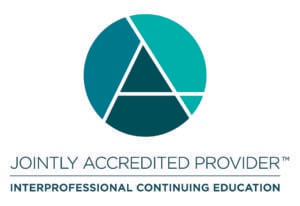UPDATED ONLINE VTE E-LEARNING COURSE WITH NO-COST CONTINUING EDUCATION (CE)
Stop the Clot® – What Every Healthcare Professional Should Know
ACTIVITY NUMBER: WB4542
Origination Date: October 10, 2023
Expiration Date: October 10, 2025
Program Description:
This enduring activity is designed to provide the most current foundational information and clinical considerations to assess and treat patients at risk of and experiencing venous thromboembolism (VTE), and to improve the ability of healthcare professionals to identify and manage these patients successfully.
Objectives:
At the conclusion of the session, the participants will be able to:
- Explain two facts about the physiology of thrombus formation and the pathogenesis of VTE.
- Describe three risk factors for VTE.
- Describe three VTE prevention options.
- Explain three processes used in VTE diagnosis.
- Explain two VTE treatment and management options.
- Describe two possible post-VTE complications.
- Identify two key strategies for improving interprofessional care.
Faculty/Credentials:
Burnett, Allison, PharmD, Inpatient Antithrombosis Stewardship Pharmacist, University of New Mexico Hospital
Cromwell, Caroline, MD, Associate Professor, Icahn School of Medicine
Frank, Cassiopeia, MMSc, PA-C, Physician Assistant, University of North Carolina Health
Patell, Rushad, MD, Assistant Professor, Harvard Medical School
Radparvar, Sara, PharmD, BCPS, BCCCP, Clinical Pharmacy Manager, Mount Sanai Hospital
Rosovsky, Rachel, MD, MPH, Hematologist, Massachusetts General Hospital and Associate Professor, Harvard Medical School
Wirth, Diane, MSN, ANP, Adult Nurse Practitioner, Grady Memorial Hospital
Witt, Daniel M., PharmD, FCCP, BCPS, Professor and Chair, University of Utah College of Pharmacy
Zwicker, Jeffrey, MD, Professor of Medicine, Memorial Sloan Kettering Cancer Center
Target Audience:
Physicians, Registered Nurses, Physician Assistants, Pharmacists, Other Allied Health Professionals
Format:
This activity is web-based.
Prerequisites:
Knowledge of clinical care or population health and basic pathophysiology of the human body.
Hardware/Software:
Computer hardware, internet connection, browser.
Materials:
None
Contact Information:
Accreditation Statements:
 In support of improving patient care, this activity has been planned and implemented by Centers for Disease Control and Prevention and The National Blood Clot Alliance. The Centers for Disease Control and Prevention is jointly accredited by the Accreditation Council for Continuing Medical Education (ACCME), the Accreditation Council for Pharmacy Education (ACPE), and the American Nurses Credentialing Center (ANCC), to provide continuing education for the healthcare team.
In support of improving patient care, this activity has been planned and implemented by Centers for Disease Control and Prevention and The National Blood Clot Alliance. The Centers for Disease Control and Prevention is jointly accredited by the Accreditation Council for Continuing Medical Education (ACCME), the Accreditation Council for Pharmacy Education (ACPE), and the American Nurses Credentialing Center (ANCC), to provide continuing education for the healthcare team.
CME: The Centers for Disease Control and Prevention designates this enduring activity for a maximum of 1.75 AMA PRA Category 1 Credits™. Physicians should claim only the credit commensurate with the extent of their participation in the activity.
AAPA CME: Credit Designation Statement – Enduring Materials
The Centers for Disease Control and Prevention has been authorized by the American Academy of PAs (AAPA) to award AAPA Category 1 CME credit for activities planned in accordance with AAPA CME Criteria. This activity is designated for 1.75 AAPA Category 1 CME credits. Approval is valid until 10/10/2025. PAs should only claim credit commensurate with the extent of their participation.
CNE: The Centers for Disease Control and Prevention designates this activity for 1.75 nursing contact hours.
CPE: The Centers for Disease Control and Prevention designated this Knowledge-based event for pharmacists to receive 0.175 CEUs in pharmacy education. The Universal Activity Number is JA4008229-9999-23-092-H01-P.
After credit is claimed, an unofficial statement of credit is immediately available on CDC TRAIN. Official credit will be uploaded within 60 days on the NABP/CPE Monitor.
CEU: The Centers for Disease Control and Prevention is authorized by IACET to offer 0.2 CEU’s for this program.
Disclosure:
In compliance with continuing education requirements, all planners, presenters must disclose all financial relationships, in any amount, with ineligible companies during the previous 24 months as well as any use of unlabeled product(s) or product(s) under investigational use.
CDC, our planners, and content experts wish to disclose they have no financial relationship(s) with ineligible companies with the exception of Dr. Burnett, and she wishes to disclose that she receives royalties as a chapter author for UptoDate; and with the exception of Dr. Rosovsky, and she wishes to disclose she is a consultant for Janssen, Abbott and Penumbra, and she is a National Lead Investigator, Storm-PE trial that Penumbra funds to Massachusetts General Hospital; and with the exception of Diane Wirth, and she wishes to disclose that she is a speaker for pharmaceuticals; and with the exception of Dr. Zwicker, and he wishes to disclose that he is a data and safety monitoring board member for CSL Behring, and a consultant for Calyx.
All of the relevant financial relationships listed for these individuals have been mitigated.
Content will not include any discussion of the unlabeled use of a product or a product under investigational use.
CDC did not accept financial or in-kind support from ineligible companies for this continuing education activity.
Registration:
To take this online course, you will need a computer and an internet connection.
If you have already registered and are returning to continue your course. please click here
Instructions for Obtaining Continuing Education (CE)
In order to receive continuing education (CE) for Stop the Clot® – What Every Healthcare Professional Should Know (web-based) – WB4542, please visit CDC TRAIN and follow these instructions before 10/10/2025.
Fees:
No fees are charged for CDC’s CE activities.
Please address questions or comments about registration or the online course to: VTEeLearning@stoptheclot.org
This project was supported by the Centers for Disease Control and Prevention of the U.S. Department of Health and Human Services (HHS) as part of a financial assistance award totaling $350,000 with 100 percent funded by CDC/HHS. The contents are those of the authors and do not necessarily represent the official views of, nor an endorsement, by CDC/HHS, or the U.S. Government.

